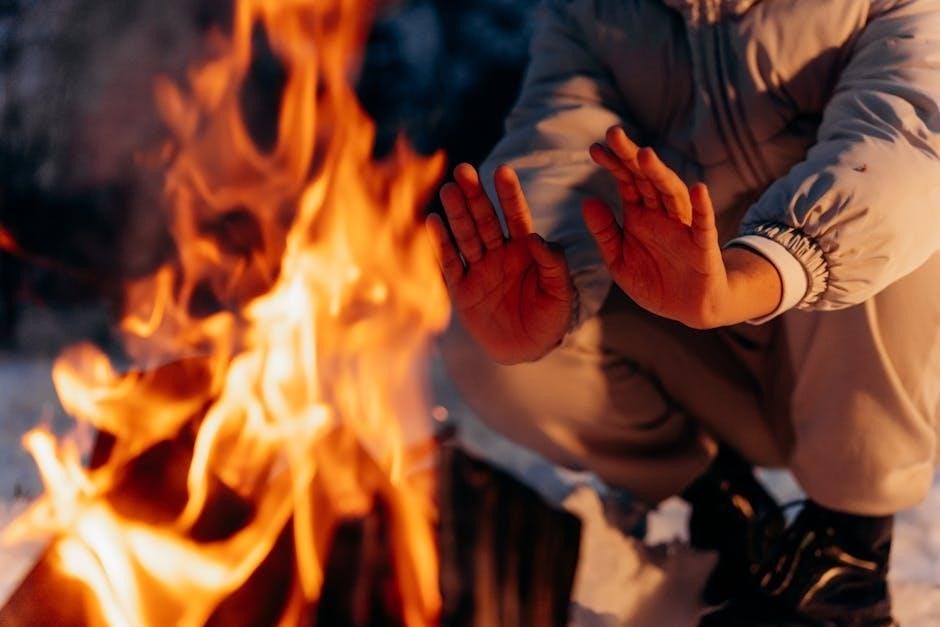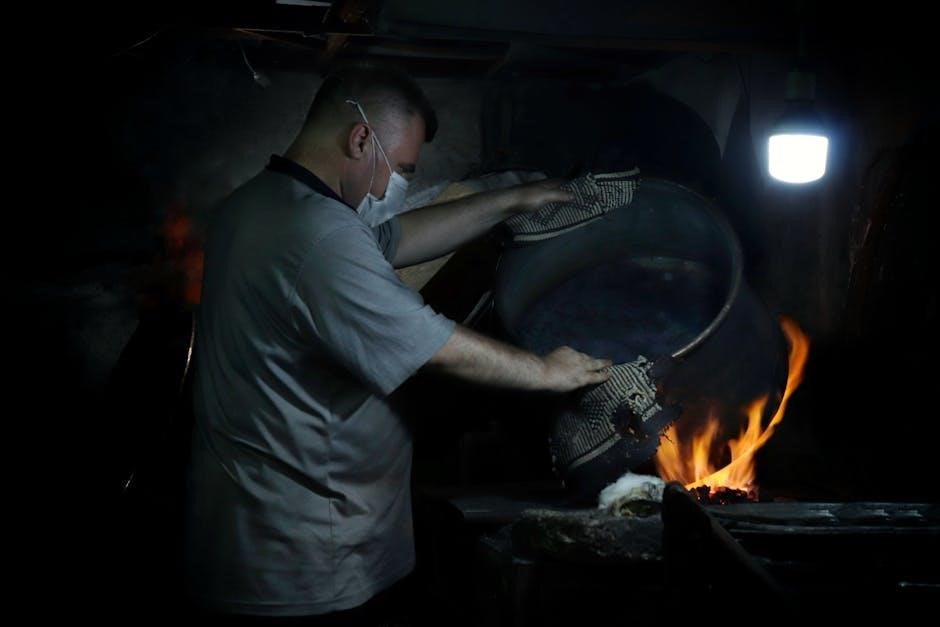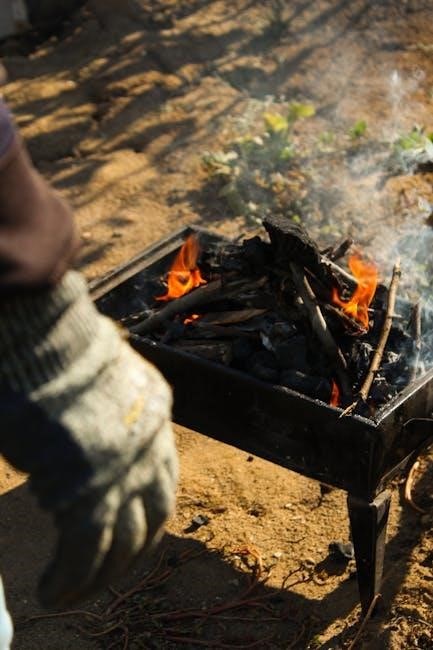Striker-fired pistols with manual safety combine modern reliability with an additional layer of security. They use a spring-loaded striker to ignite the primer, offering a sleek, hammerless design. These pistols often feature an external thumb safety, providing an extra level of control and safety, appealing to users who prefer added security without compromising functionality.
1.1 Definition and Mechanism of Striker-Fired Pistols
A striker-fired pistol uses a spring-loaded striker to ignite the cartridge primer, eliminating the need for a hammer. This design provides a sleek, compact profile and reliable ignition. Unlike hammer-fired pistols, striker-fired models rely on internal mechanisms, such as firing pin blocks, to ensure safe operation and prevent accidental discharge.
1.2 Importance of Manual Safety in Modern Pistols
Manual safety adds an extra layer of security, providing a physical barrier against accidental discharge. This feature is especially valued in high-stress situations, where an unintended trigger pull could have dire consequences. It offers users a sense of control and confidence, enhancing overall safety without compromising the pistol’s functionality.
Design and Functionality of Striker-Fired Pistols with Manual Safety
Striker-fired pistols with manual safety integrate a sleek, hammerless design with an external thumb safety, enhancing control and security. Internal mechanisms ensure reliability and safe operation.
2.1 Internal Safety Mechanisms in Striker-Fired Pistols
Striker-fired pistols feature internal safety mechanisms like firing pin blocks and drop safeties, preventing accidental discharge. These systems ensure the striker only moves when the trigger is deliberately pulled, enhancing reliability and safety without relying solely on the manual safety.
2.2 Role of the Manual Safety in Enhancing Security
The manual safety on striker-fired pistols provides an additional layer of control, preventing accidental discharges; It offers users an extra measure of security, especially during carry, and appeals to those who prefer added safety without compromising accessibility in critical situations.
2.3 Integration of Manual Safety with Striker Mechanics
The manual safety in striker-fired pistols integrates seamlessly with the striker mechanism, often blocking the striker’s movement or preventing sear release. This design ensures the striker cannot ignite the primer unless the safety is disengaged, providing an additional layer of control and enhancing overall firearm security and user confidence.

Safety Features and Reliability
Striker-fired pistols with manual safety combine internal mechanisms like firing pin blocks and trigger safeties with an external thumb safety, ensuring enhanced control and reliability, preventing accidental discharge in various scenarios.
3.1 Passive Safety Mechanisms in Striker-Fired Pistols
Passive safety mechanisms in striker-fired pistols include internal components like firing pin blocks and drop safeties. These features prevent accidental discharge without requiring user interaction, ensuring reliability even when dropped or subjected to unintended force, thereby enhancing overall safety and reducing the risk of negligent discharges.
3.2 Active Safety Mechanisms: Manual Safety and Trigger Safeties
Active safety mechanisms, such as manual safety and trigger safeties, provide intentional engagement to prevent accidental discharges. Manual safeties add an extra layer of control, while trigger safeties ensure the striker only moves when the trigger is fully pressed, enhancing safety without compromising performance.
3.3 Drop Safety and Firing Pin Block Systems
Drop safety and firing pin block systems are critical passive mechanisms in striker-fired pistols. These systems prevent the firing pin from striking the primer unless the trigger is intentionally pressed, even if the pistol is dropped. This enhances reliability and prevents accidental discharges, adding a layer of protection for users.

User Perspectives and Preferences
Users of striker-fired pistols with manual safety often debate its practicality. Enthusiasts value the added security, while critics argue it complicates emergency responses.
4.1 Arguments in Favor of Manual Safety on Striker-Fired Pistols
Proponents argue that manual safety offers an extra layer of control and security, preventing accidental discharges. It provides a visible and tactile confirmation of the pistol’s status, enhancing safety, especially for new shooters. Additionally, it allows users to carry the pistol in a “cocked and locked” condition, ensuring quick readiness while maintaining safety.
4.2 Criticisms and Concerns About Manual Safety
Some argue that manual safety adds complexity and can be a hindrance in high-stress situations, potentially causing delays. Critics also point out the risk of accidentally engaging or disengaging the safety, which could lead to unintended consequences. Additionally, the extra mechanism may be perceived as unnecessary by those who rely on internal safeties alone.
4.3 User Experiences with Popular Models
Users of striker-fired pistols with manual safety often praise models like the Smith & Wesson M&P and Walther VP9 for their reliability and ergonomic design. Many appreciate the added security of the manual safety, though some find it unnecessary or cumbersome. Experiences vary, with enthusiasts emphasizing the balance between safety and functionality.

Popular Models of Striker-Fired Pistols with Manual Safety
Models like the Smith & Wesson M&P with manual safety and Walther VP9 are highly regarded for their reliability and ergonomic design, appealing to users seeking enhanced security.
5.1 Smith & Wesson M&P with Manual Safety
The Smith & Wesson M&P with manual safety offers a reliable and ergonomic design, combining the simplicity of a striker-fired system with the added security of a thumb safety. This feature provides users with an extra layer of control, appealing to those who prioritize safety and ease of use in concealed carry situations, ensuring a balance between functionality and personal preference.
5.2 Walther VP9 and Its Safety Features
The Walther VP9 stands out with its optional manual safety, offering users a choice in security. Its ergonomic design and crisp trigger pull make it highly reliable. While some critics note the paddle mag release, the VP9 remains popular for its balance of performance and safety, catering to diverse shooter preferences effectively.
5.3 Other Notable Models and Their Characteristics
Beyond the Walther VP9 and Smith & Wesson M&P, other notable models include the Sig Sauer P229, known for its reliability, and the CZ P-10 C, praised for its ergonomic design. The FN 509 also stands out, offering durability and versatility. These models cater to diverse preferences, combining safety with performance effectively.

Comparison with Other Pistol Designs
Striker-fired pistols with manual safety differ from hammer-fired designs by eliminating the external hammer, offering a sleeker profile and optional manual safety for enhanced control and versatility.
6.1 Striker-Fired vs. Hammer-Fired Pistols
Striker-fired pistols use a spring-loaded striker to ignite the primer, offering a sleek, hammerless design. Hammer-fired pistols rely on an external hammer to strike the firing pin. Striker-fired models are often more concealable and feature fewer moving parts, while hammer-fired pistols provide tactile feedback and a decocking option for safe handling.
6.2 Manual Safety vs. No Manual Safety in Striker-Fired Pistols
Striker-fired pistols with manual safety have an external thumb lever for added control, appealing to those who want extra security. Pistols without manual safety use internal mechanisms like trigger safeties, offering quick access in emergencies. User preferences vary; some prefer the added safety, while others favor simplicity and speed without manual safety.
6;3 Advantages and Disadvantages of Each Design
Manual safety striker-fired pistols offer enhanced security but may delay quick access in emergencies. Non-manual safety designs prioritize speed and simplicity, relying on internal safeties. Manual safety appeals to cautious users, while non-manual suits those who trust internal mechanisms and prioritize rapid deployment, highlighting a trade-off between added security and immediate action.

Carry and Handling Best Practices
Proper holstering, consistent manual safety engagement, and awareness of the pistol’s condition ensure safe and effective carry. Regular practice enhances readiness for emergencies and routine handling.
7.1 Concealed Carry Considerations
Concealed carry with striker-fired pistols requires careful consideration of holster selection, manual safety engagement, and awareness of the pistol’s condition. The thumb safety adds an extra layer of security, reducing accidental discharge risks. Proper holstering and consistent training ensure safe and reliable carry in dynamic environments.
7.2 Condition of Readiness: Cocked and Locked vs. Other Methods
Striker-fired pistols with manual safety can be carried in various readiness conditions. “Cocked and locked” is less applicable since there’s no hammer, but engaging the manual safety provides similar security. Other methods include “condition 0” (ready to fire) or “condition 1” (with safety on), balancing quick access with added safety.
7.3 Emergency Situations and Manual Safety Engagement
In high-stress situations, the manual safety on striker-fired pistols provides an added layer of control. However, it requires deliberate action to disengage, which can delay response times. Proper training and muscle memory are critical to ensure quick and safe operation during emergencies, balancing security with rapid access when needed most.
Maintenance and Upkeep
Regular cleaning and lubrication of striker-fired pistols with manual safety are essential for reliability. Proper care ensures smooth operation and prevents corrosion or mechanical issues over time.
8.1 Cleaning and Lubrication of Striker-Fired Pistols
Regular cleaning and lubrication are crucial for striker-fired pistols with manual safety. Focus on the striker, firing pin, and trigger mechanism to ensure smooth operation. Use high-quality gun oil to prevent corrosion and maintain reliability. Proper maintenance extends the pistol’s lifespan and ensures consistent performance in all conditions.
8.2 Maintenance of Manual Safety Components
Regular inspection and cleaning of the manual safety lever and its components are essential. Ensure the safety engages smoothly and reliably. Use mild solvents to remove debris and apply a small amount of high-quality gun oil to moving parts. Proper lubrication prevents wear and ensures consistent functionality over time.
8.3 Tips for Ensuring Reliable Functionality
Regularly clean and lubricate all moving parts, including the striker and safety mechanisms. Inspect for wear or debris that could affect performance. Use high-quality ammunition and avoid low-quality magazines. Store the pistol in a dry environment and follow manufacturer guidelines for maintenance to ensure consistent and reliable operation over time.
Legal and Liability Considerations
Carrying a striker-fired pistol with manual safety involves legal implications, including self-defense liability and compliance with local laws. Proper training and adherence to regulations are essential.
9.1 Legal Implications of Carrying a Pistol with Manual Safety
Carrying a striker-fired pistol with manual safety involves legal implications, including self-defense laws and liability concerns. The presence of a manual safety may influence court interpretations of intent and negligence. Adherence to local regulations and understanding of self-defense statutes are crucial to avoid legal complications and ensure responsible firearm ownership.
9.2 Liability Concerns in Self-Defense Situations
Carrying a striker-fired pistol with manual safety raises liability concerns in self-defense situations. The presence of a manual safety may be interpreted as an intent to use lethal force, potentially affecting legal outcomes. Proper training and understanding of when to engage the safety are crucial to avoid accidental discharges and legal repercussions.
9.3 Compliance with Local and Federal Regulations
Owners of striker-fired pistols with manual safety must comply with local and federal laws, including background checks, permits, and age restrictions. Regulations vary by jurisdiction, potentially impacting carrying methods and storage requirements. Understanding and adhering to these laws is essential to avoid legal consequences and ensure responsible firearm ownership.

Training and Education
Proper training is crucial for safe and effective use of striker-fired pistols with manual safety. Understanding safety mechanisms, trigger control, and emergency procedures ensures responsible firearm handling and minimizes risks.
10.1 Importance of Proper Training with Manual Safety
Proper training with striker-fired pistols featuring manual safety is essential for safe handling and effective use. It ensures users understand how to engage/disengage the safety, develop muscle memory, and maintain control. Training also covers safe carry practices, emergency procedures, and legal considerations, reducing accidents and enhancing confidence in high-stress situations.
10.2 Drills and Exercises for Effective Use
Practicing drills like target transitions, rapid engagements, and safety manipulation enhances proficiency with striker-fired pistols. Regular exercises, such as drawing from holster and engaging/disengaging the manual safety, build muscle memory and ensure quick, accurate responses in stressful situations, improving overall control and confidence in real-world scenarios.
10.3 Avoiding Common Mistakes with Manual Safety
Common mistakes include forgetting to disengage the manual safety in emergencies and improper handling during carry. Ensure consistent training to build muscle memory for safe engagement/disengagement. Avoid over-reliance on manual safety by combining it with proper trigger discipline and holstering practices to enhance overall firearm safety and operational effectiveness.
Future Trends and Innovations
Future trends may include enhanced striker designs, smarter manual safety integration, and ergonomic advancements. Innovations like adjustable triggers and modular systems could rise, driven by consumer demand for versatility and reliability in modern pistols.
11.1 Evolution of Manual Safety in Modern Pistols
The manual safety in modern striker-fired pistols is evolving to become more ergonomic and intuitive. Designers are focusing on creating ambidextrous controls and smoother engagement mechanisms. These enhancements aim to improve accessibility and usability without compromising the pistol’s sleek, compact design, catering to both professional and civilian users effectively.
11.2 Technological Advances in Striker-Fired Designs
Modern striker-fired pistols benefit from advancements in materials science, trigger systems, and safety mechanisms. Improved manufacturing techniques enable lighter, durable frames and smoother trigger pulls. Enhanced drop safety and firing pin block systems ensure reliability. These innovations maintain the simplicity of striker-fired designs while elevating performance and user confidence in critical situations.
11.3 Consumer Demand and Market Trends
Consumer demand for striker-fired pistols with manual safety continues to grow, driven by preferences for added security and control. Popular models like the Smith & Wesson M&P and Walther VP9 highlight this trend. Users often favor these pistols for concealed carry and home defense, valuing the extra layer of safety they provide in high-stress situations.
Striker-fired pistols with manual safety offer a blend of modern design and enhanced security, catering to users who prioritize control and reliability. Their popularity in concealed carry and home defense underscores their effectiveness. As technology evolves, these pistols remain a preferred choice for those valuing both functionality and safety.
